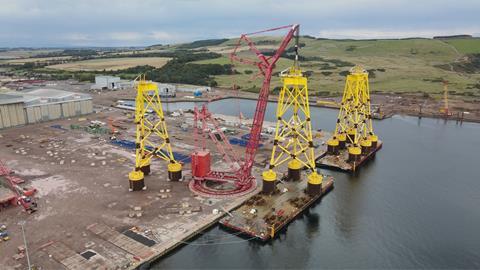The Netherlands-headquartered transport engineering and heavy lift specialist Mammoet has shared further details of its role at the Seagreen project, Scotland’s largest offshore wind farm.
Offshore wind energy projects taking place in macrotidal environments, such as those around the UK, must deal with water level changes of more 4 m every six hours. This extreme tidal range is difficult to compensate for using ballasting, so projects that require load-in or load-out of large jackets are delayed when waters are too high or low, leaving the installation vessel waiting. Working years in advance, Mammoet proposed a large ring crane solution that would allow manoeuvres to take place regardless of the tidal conditions, and so reduce the downtime of offshore assets and help to deliver first power as scheduled.
The conventional approach to a project such as this would be to mobilise a fleet of SPMTs, then use these to complete all manoeuvres. Mammoet said that this was the original plan for the project, although it imposes many limitations on how the work can be performed, giving rise to hidden costs. With 114 jackets to load-in and load-out, these would quickly add up.
For example, while ballasting can be used to overcome changing water levels, if the tidal range is too large then the required barge height cannot be maintained, and the operational window is closed. Also, if SPMTs need to drive on and off the barge, then deck space needs to be permanently cleared. This limits the area available for stowing the jackets, grillage beams and sea fastening. Larger and stronger barges can overcome these limitations, but this reduces size of the fleet that can be used for the project, causing supply chain issues and driving up project costs.
Having been involved with the project since 2018 and sharing a close working relationship with its customer Global Energy Group, Mammoet’s engineers were able to look beyond just the heavy transport scope. This allowed them to provide a more efficient alternative to SPMT transport.
The use of SPMT transporters alongside the PTC 210 DS ring crane removed the impact of tidal shifts on the project schedule, increasing the length of each load-out window. The five-hour operational time that would be expected for an SPMT load-out of this nature typically allows for only a single manoeuvre per shift, as once a first movement is complete, tide conditions prevent another from taking place. Crane lifting has no such limits as the barge deck no longer needs to remain level with the quay.
Mammoet added that the ring crane also enabled smooth parallel operations, as it could load-out jackets to a waiting vessel while SPMTs offloaded others. Outside the delivery windows, jackets could be brought to the quayside, within lifting range of the crane, well in advance of a vessel arriving from offshore, cutting down significantly on crane waiting time and so maximising the output of the installation vessel.

Where it takes roughly one shift to load each jacket using SPMTs – even if conditions are good – the PTC 210 DS is capable of loading-out two jackets in a single shift, providing barges are ready for it. This accelerates the pace of work significantly, increasing the feeder vessel cycle time and reducing downtime for the installation vessel at sea.
Mammoet UK technical sales manager, Oliver Smith, explained: “As ever, when an organisation is deciding on a project of this scale, cost-efficiency is always an important factor. We were involved with this project years in advance – well before some of the full details came to light. It was only further down the line that we needed to reassess the situation and move away from SPMT-only operations.”
He added: “This change in plan wasn’t small either; we knew that our customer would in turn need to secure buy-in from their customer that the proposed solution would deliver results.”
To assure the client, Mammoet integrated engineering teams to demonstrate the flexibility of the solution and work through the risk, while in parallel, it worked with the customer on the commercial calculations.
With the plans agreed and finalised, the loading operation commenced in July 2021 when the first jackets were delivered to Nigg Energy Park, loaded-in using SPMTs, then offloaded and stored in their pre-positioned blocking arrangement onsite. In September 2021, the jackets were lifted from this arrangement and transferred to the quay edge via SPMT, and from there were loaded onto the feeder barges using the PTC 210 DS ring crane. They were then tugged to the installation vessel and installed 27 km from the coast of Angus by the project’s EPCI contractor, Seaway 7. The final jacket was installed in April 2023.
















